
Current Issues:
SpaceViews
SpaceViews Update
Breaking News
Back Issues
Search
Subscriptions
Submissions
Forum
Space Sites of the Week
Home
Future Missions
Mars Pathfinder is just the first of a fleet of spacecraft planned to study the Red Planet in detail over a 10-year period. While mostly American, there is one Japanese spacecraft and Russia and Europe may contribute missions of their own in later years. Here is an overview of what's to come in the next several years: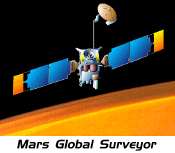 The next mission to Mars is already en route. Launched in November 1996, a month before Mars Pathfinder, Mars Global Surveyor (MGS) will reach the Red Planet this September. MGS will use aerobraking in the Martian atmopshere, along with its own thrusters, over a four-month period to put itself into a circular polar orbit around Mars. By March 1998 it will begin its mission to study the planet from orbit.
The next mission to Mars is already en route. Launched in November 1996, a month before Mars Pathfinder, Mars Global Surveyor (MGS) will reach the Red Planet this September. MGS will use aerobraking in the Martian atmopshere, along with its own thrusters, over a four-month period to put itself into a circular polar orbit around Mars. By March 1998 it will begin its mission to study the planet from orbit.
Mars Global Surveyor will perform some of the tasks Mars Observer would have done had contact with the ill-fated spacecraft not been lost just before reaching Mars in August 1993. The spacecraft carries five major instruments, some of which are flight spares from Mars Observer. The instruments include:
- a camera capable of high-resolution images of the planet's surface as well as wide-field images to study the surface and atmosphere;
- a spectrometer that will record thermal infrared radiation emitted by rocks, soil, ice, and dust and clouds in the atmopshere;
- a laser altimeter that will provide accurate data on the height of the Martian surface that will be used for topographic maps;
- a magnetometer that will look for any evidence of a magnetic field around Mars, and;
- a radio science package that will use signals transmitted by the spacecraft and picked up by Earth to study the Martian gravity field and atmopshere.
In addition, MGS carries a relay antenna that will be used by future spacecraft to transmit data between the Martian surface and Earth.
JPL maintains extensive information about Mars Global Surveyor online at the MGS Web site, http://mgs-www.jpl.nasa.gov/.
NASA will return to the Red Planet in the next launch window, with launches of two spacecraft in late 1998 and early 1999. One will orbit the planet like Mars Global Surveyor, the other is an advanced lander. In addition, two small spacecraft will hitchhike to Mars on the lander and detach before arrive to impact on the planet and deploy probes below the Martian surface All spacecraft will work together to provide a detailed look at Mars's atmosphere, climate, and water and carbon dioxide budgets.
Mars Surveyor 1998 Orbiter
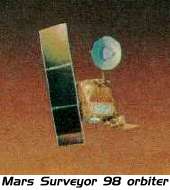 Like Mars Global Surveyor, Mars Surveyor 1998 Orbiter will go into a polar orbit around the planet, using aerobraking to help circularize its orbit. The orbiter carries only two main instruments, a camera and the Pressure Modulator Infrared Radiometer (PMIRR), which will study temperature, water vapor, and dust in the atmosphere. The spacecraft will also serve as a relay between the lander and Earth.
Like Mars Global Surveyor, Mars Surveyor 1998 Orbiter will go into a polar orbit around the planet, using aerobraking to help circularize its orbit. The orbiter carries only two main instruments, a camera and the Pressure Modulator Infrared Radiometer (PMIRR), which will study temperature, water vapor, and dust in the atmosphere. The spacecraft will also serve as a relay between the lander and Earth.
The four main goals of the orbiter are:
- monitor daily changes in the Martian atmosphere
- record the temperature profile of the atmosphere
- record the levels of dust and water vapor in the atmopshere
- look for changes on the Martian surface caused by atmopshere effects.
Mars Surveyor 1998 Orbiter is scheduled for launch in December 1998, and will arrive at Mars about 10 months later. The NSSDC has some information about the mission online at http://nssdc.gsfc.nasa.gov/cgi-bin/database/www-nmc?MARS98S.
Mars Surveyor 1998 Lander
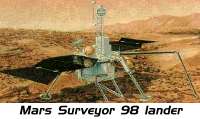 The companion to the orbiter, Mars Surveyor 1998 Lander, will land on the Martian surface near the south polar cap in an area of layered deposits created by the polar cap. The goals of the lander are to record the local meteorological conditions, look for water or carbon dioxide in
the deposits, study the interior of the deposits by digging small trenches, and perform general studies, inclding imaging, of the overall terrain.
The companion to the orbiter, Mars Surveyor 1998 Lander, will land on the Martian surface near the south polar cap in an area of layered deposits created by the polar cap. The goals of the lander are to record the local meteorological conditions, look for water or carbon dioxide in
the deposits, study the interior of the deposits by digging small trenches, and perform general studies, inclding imaging, of the overall terrain.
Unlike Mars Pathfinder, which uses airbags to cushion its landing, the lander will use a more conventional combination of parachutes, thursters, and landing legs for a soft landing. The instruments on the lander include several cameras and a gas analyzer. Russia will provide a laser ranger to perform measurements of dust and haze in the atmopshere. A 2-meter (6.6-foot) robot arm is included in the lander.
The lander will actually launch not in 1998 but in the first week of 1999, at the beginning of a two-week launch window. It will land on Mars in December 1999. More information is available from the NSSDC at http://nssdc.gsfc.nasa.gov/cgi-bin/database/www-nmc?MARS98L.
New Millennium Deep Space 2
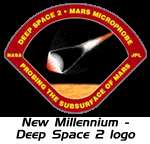 Hitchiking to Mars with the lander will be two small spacecraft that are part of NASA/JPL's "New Millennium" program of developing small spacecraft missions using advanced technology. The two spacecraft, each weighing less than 2 kg (4.4 lbs.) each, will fly to Mars attached to the Mars 1998 Surveyor Lander. Just before arrival at Mars, the two probes will detach and enter Mars atmosphere, each protected by an aeroshell. They will hit the Martian surface at high speed, shattering the aeroshells, but keeping the spacecraft intact.
Hitchiking to Mars with the lander will be two small spacecraft that are part of NASA/JPL's "New Millennium" program of developing small spacecraft missions using advanced technology. The two spacecraft, each weighing less than 2 kg (4.4 lbs.) each, will fly to Mars attached to the Mars 1998 Surveyor Lander. Just before arrival at Mars, the two probes will detach and enter Mars atmosphere, each protected by an aeroshell. They will hit the Martian surface at high speed, shattering the aeroshells, but keeping the spacecraft intact.
Each spacecraft consists of a "aft body" which will remain on the surface and a "fore body" which will burrow into the Martian surface to a depth of 30 to 200 centimeters (1 to 6.6 feet), using the force of the impact to drive into the surface. Cabling will connect the two pieces and allow data from the fore body to be returned to Earth via antennae on the aft body and the relay antenna on the Mars Global Surveyor spacecraft.
The probes will look for evidence of water ice in the Martian subsurface, measure the temperature gradient below the surface, and measure atmospheric temperatures and pressures using instruments on the aft body. JPL's New Millennium project office has more information about the mission at http://nmp.jpl.nasa.gov/DS2/.
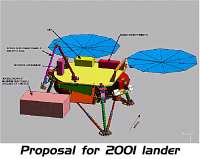 NASA has plans to launch robotic missions to Mars at every launch opporunity -- every 26 months -- through 2005. The scope of the future missions are still under development, and will change based on experience gained with earlier missions, but some details are available.
NASA has plans to launch robotic missions to Mars at every launch opporunity -- every 26 months -- through 2005. The scope of the future missions are still under development, and will change based on experience gained with earlier missions, but some details are available.
The next launch opportunity after the 1998-1999 missions, in 2001, will feature an orbiter and a lander. The lander, which would be launched in April 2001, would be somewhat similar to the 1998 lander, but land closer to the equator. It will include a larger version of the rover on Mars Pathfinder, capable of extended operations. The lander will also include experiments to test the in situ production of propellant that would be needed for future robotic and human missions. Read the basics about the mission at http://nssdc.gsfc.nasa.gov/cgi-bin/database/www-nmc?MS2001L.
The 2001 orbiter would launch in March 2001 and arrive just before end of the year. The spacecraft will use an aerocapture maneuver that uses the Martian atmopshere almost entirely to slow down and go into orbit. The spacecraft will include a suite of instruments such as a camera, gamma-ray spectrometer, and neutron detector. Read the basics about the mission at http://nssdc.gsfc.nasa.gov/cgi-bin/database/www-nmc?MS2001S.
The probes scheduled for launch in May/June 2003 and July/August 2005 are still undefined. However, it's likely that the 2005 opportunity will include a sample return mission. A spacecraft would land on the surface, collect rock and soil samples, and return the samples to Earth. Depending on the results of experiments on the 2001 and perhaps 2003 missions, the spacecraft will produce the propellants needed for the return trip while on the surface, saving considerable weight and money. An overview of the mission proposals are available at http://nssdc.gsfc.nasa.gov/planetary/mars_2003_05.html.
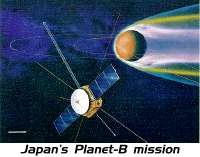 Japan's first mission to Mars will be in 1998 with the launch of Planet-B. Launched using Japan's new M-V booster in August or early September 1998, Planet-B will go into orbit around Mars to study the magnetic fields, if any, around Mars. It will also look at the Martian ionosphere and the interaction between the planet and the solar wind.
Japan's first mission to Mars will be in 1998 with the launch of Planet-B. Launched using Japan's new M-V booster in August or early September 1998, Planet-B will go into orbit around Mars to study the magnetic fields, if any, around Mars. It will also look at the Martian ionosphere and the interaction between the planet and the solar wind.
The probe will take an unusual route to the Red Planet. If launched in August 1998, it will swingby the Moon in September and again in December before swinging by the Earth. The gravity assists will give the specacraft enough velocityn to travel to Mars, arriving there in October 1999. ISAS, the Japanese space science agency that will operate the mission, has some bare-bones information on the mission at http://www.isas.ac.jp/info/future/planetB-e.html.
European and Russian plans for Mars missions are uncertain. One European Space Agency proposal called for a joint ESA-NASA mission called InterMarsNet. Launched in 2003, it would have features a European orbiter and three NASA landers. However, it was passed over in the Horizon 2000 mission program for another project. More recently, ESA officials have considered a "Mars Express" mission for around the same time that would feature some of the experiments flown on the ill-fated Russian Mars 96 mission.
Russian plans are even more uncertain, given the financial difficulties in Russia today. A "Mars Together" mission with the United States in 2001 has been proposed, but funding for the program must still be secured; a difficult prospect for the cash-strapped Russian space program.
There are currently no firm plans for human missions to Mars, although there has been no shortage of studies and proposals for manned missions. Most recently, a study by a team at the Johnson Space Center called for a $40-billion manned Mars program that would include human missions to the Red Planet in 2009, 2012, and 2014. These missions would establish a base on the planet and lead up to permanent habitation of the planet by 2016. This mission proposal is still being studied by NASA Headquarters. Other mission proposals have called for human landings on Mars later in the 2010s or by 2020. SpaceViews Update had an article on the most recent proposal in the June 15 issue.
Of course, all these require appropriate funding. Any Mars mission will certainly cost less than the $400-500 billion price tag proposed in the infamous "90-Day Study" by NASA and a team of aerospace contractors when President Bush first proposed the Space Exploration Initiative (which called for humans on Mars by 2019). Even the authors of the most recent study acknowledge that a $40-billion proce tag for the mission may be far more expensive that what NASA and the nation as a whole would be willing to support. Some proposals, though, such as Robert Zubrin's Mars Direct, could cost as little as a few billion dollars.
